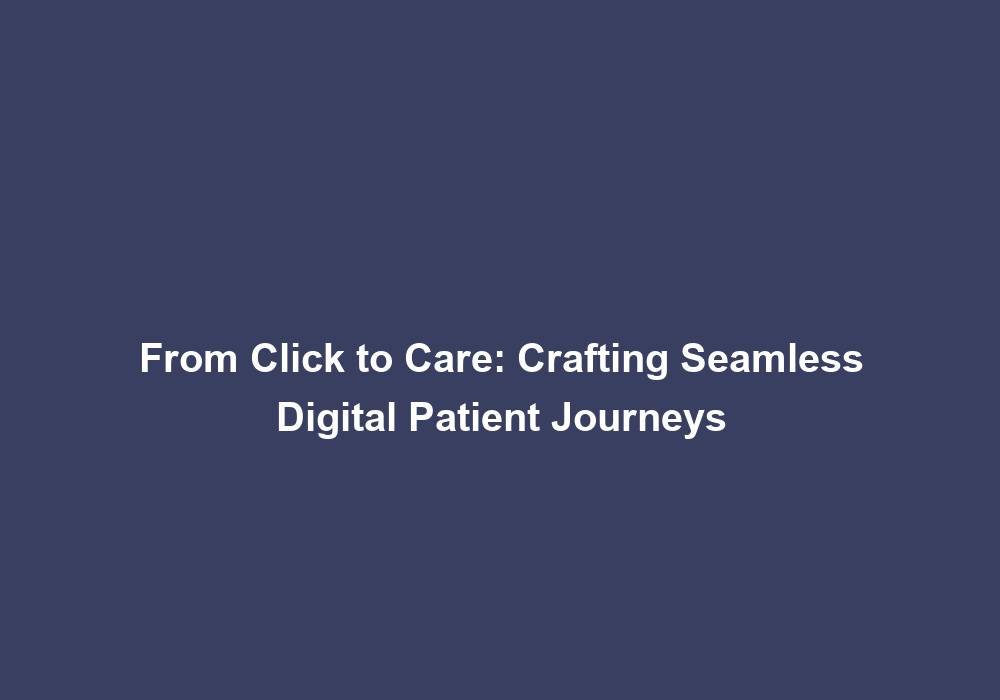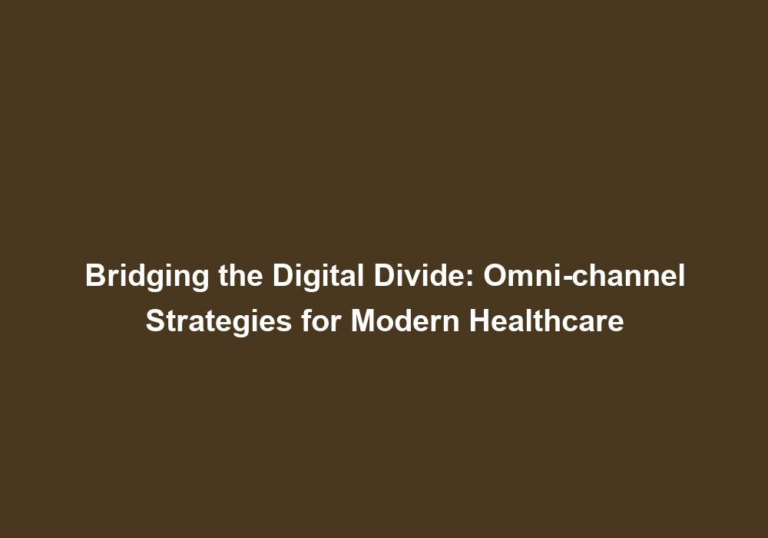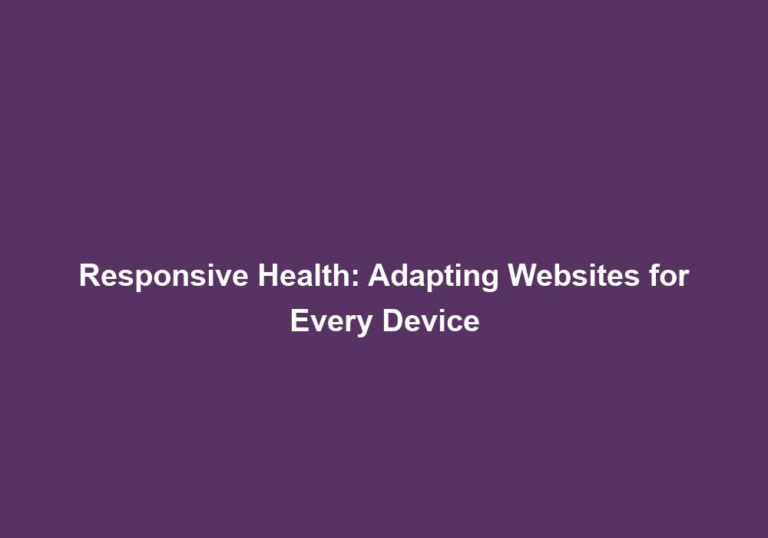Navigating the Digital Healthscape: Optimizing Patient Journeys Online
The digital landscape has revolutionized the way patients navigate and access healthcare information. With the advent of the internet and the proliferation of digital platforms, patients now have a wealth of resources at their fingertips. As a result, healthcare providers and organizations must adapt to this new era and optimize patient journeys online to ensure they are meeting the needs and expectations of their target audience.
The Importance of Optimizing Patient Journeys Online
In today’s digital age, patients are increasingly turning to the internet to research symptoms, find healthcare providers, and educate themselves about medical conditions. Optimizing patient journeys online is crucial for healthcare organizations as it allows them to effectively engage with their target audience, build trust, and ultimately drive patient conversion.
By providing a seamless and user-friendly online experience, healthcare providers can attract and retain patients, improve patient satisfaction, and enhance their overall reputation. A well-optimized patient journey not only helps patients find the information and services they need but also encourages them to take action and become active participants in their own healthcare.
Key Strategies for Optimizing Patient Journeys Online
1. User-Centric Website Design:
The first step in optimizing patient journeys online is to ensure that your website is user-centric and optimized for a seamless browsing experience. This includes:
-
Mobile Responsiveness: With the majority of internet users accessing information through their mobile devices, it is crucial to have a website that is fully responsive and mobile-friendly. This ensures that patients can easily navigate and access your website regardless of the device they are using.
-
Intuitive Navigation: Implement clear and intuitive navigation menus that allow users to easily find the information they are seeking. Use descriptive headings and subheadings to guide users through your site’s content. This helps patients quickly locate the information they need, reducing frustration and improving their overall experience.
-
Fast Loading Speed: Slow loading times can lead to user frustration and abandonment. Optimize your website’s loading speed to ensure a smooth and efficient browsing experience. This can be achieved by optimizing image sizes, minimizing server requests, and utilizing caching techniques.
2. Search Engine Optimization (SEO):
To improve your website’s visibility in search engine results and attract organic traffic, it is essential to implement effective SEO strategies. This includes:
-
Keyword Research: Identify relevant keywords and phrases that potential patients may use when searching for healthcare information or services. Incorporate these keywords naturally throughout your website’s content, including headings, subheadings, and body text. This helps search engines understand the relevance of your content and rank it higher in search results.
-
Meta Tags: Craft compelling meta titles and descriptions that accurately summarize the content of each webpage. These tags appear in search engine results and can greatly impact click-through rates. By optimizing meta tags, you can increase the chances of users clicking on your website in search results.
-
Quality Content: Produce informative and engaging content that addresses common patient queries and concerns. Well-written articles and blog posts not only attract readers but also establish your organization as a trusted authority in the healthcare industry. This can lead to higher search engine rankings and increased organic traffic.
3. Online Appointment Scheduling:
Streamlining the appointment scheduling process is crucial for optimizing patient journeys online. Provide patients with the ability to schedule appointments conveniently through your website or a dedicated online portal. This eliminates the need for time-consuming phone calls and allows patients to book appointments at their own convenience. By offering online appointment scheduling, you can improve patient satisfaction and reduce administrative burden.
4. Patient Testimonials and Reviews:
Building trust is essential when it comes to healthcare. Including patient testimonials and reviews on your website can significantly boost credibility and encourage potential patients to choose your services. Consider showcasing positive patient experiences and outcomes to demonstrate the quality of care provided by your organization. This social proof can help alleviate patient concerns and increase their confidence in your services.
5. Personalization and Patient Engagement:
To enhance the patient experience, consider implementing personalized features and engagement strategies. This includes:
-
Tailored Content: Utilize data and analytics to personalize content based on the specific needs and preferences of your target audience. This can include recommending relevant articles, resources, or services based on their browsing history. By delivering personalized content, you can provide patients with relevant information that is tailored to their individual needs.
-
Interactive Tools: Incorporate interactive tools such as symptom checkers, health risk assessments, or educational quizzes that actively engage patients and offer personalized insights. These tools can help patients assess their health condition, identify potential risks, and make informed decisions about their healthcare.
-
Email Marketing: Implement email campaigns to stay connected with patients and provide them with valuable information, updates, and offers. Personalize these emails to ensure they are relevant and useful to each recipient. By nurturing the relationship through personalized emails, you can keep patients engaged and informed, ultimately improving their overall experience.
6. Patient Education and Resources:
Empowering patients with knowledge is a key aspect of optimizing their online journey. Provide comprehensive and easy-to-understand educational resources, such as articles, videos, infographics, and FAQs, to help patients make informed decisions about their healthcare. By offering educational resources, you can empower patients to take control of their health and actively participate in their own care.
7. Social Media Presence:
Utilize social media platforms to reach and engage with a wider audience. Share relevant and informative content, respond to patient queries and feedback, and promote your services. Social media can serve as a valuable tool for building rapport and trust with potential patients. By actively engaging with patients on social media, you can establish your organization as a reliable source of information and foster a sense of community.
Conclusion
In today’s digital healthscape, optimizing patient journeys online is paramount for healthcare providers to remain competitive and meet the evolving needs of patients. By implementing user-centric website design, effective SEO strategies, personalized engagement, and offering valuable resources, healthcare organizations can create a seamless and satisfying digital experience for patients. Embracing the digital revolution allows healthcare providers to build trust, attract new patients, and enhance patient satisfaction throughout their healthcare journey.







